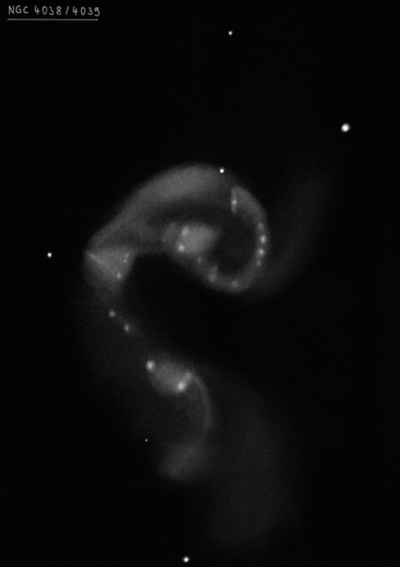Antennae Galaxies
Antennae Galaxies

William Herschel discovered NGC 4038 = H IV-28.1 = h1052 on 7 Feb 1785 (sweep 368) and recorded "pB, L. Two joined together [with NGC 4039], the smallest south; or one opening with a branch very faintly joined." WH gave a single entry in class IV (planetary), though John Herschel separated these into IV 28.1 and IV 28.2 in the Slough catalogue. Bindon Stoney sketched the galaxy pair on 14 Apr 1852 (included in LdR's 1861 publication). It appears to show one of the long tidal tails.
The long "Antennae" tidal tails were first photographed by Carl Lampland with the 40-inch Lowell reflector in 1917. J.C. Duncan remarked "Most remarkable of all, two faint extensions, like antennae" in the 1923 "Photographic studies of nebulae.III." The Toomre's adopted the nickname "the Antennae" in their early 1972 computer simulation "Galactic Bridges and Tails".
300/350mm - 13" (5/21/82): appears as two irregular galaxies connected at the east end.
400/500mm - 17.5" (5/14/88): fairly bright, moderately large. Forms a striking "shrimp-like" or "comma" shape with the tail attached at the east end and extending to the south. Appears clearly darker between the two objects on the west side.
600/800mm - 24" (4/10/08 - Magellan Observatory, Australia): this was an amazing object in the 24" at 350x. The main, bright northern component (NGC 4038) was partially annular, with a very bright knotty rim and a darker center giving a truly unique appearance for a galaxy. At least 3 knots were visible embedded along its rim. On the SE side is the brightest knot (the nucleus of the galaxy) which appeared faint, small, ~12" diameter. A second fainter knot is on the west side and was only ~6" in size. Finally, a third very faint 6" knot is on the north side. The three knots were roughly spaced out 120° apart along the outer portion of this tortured galaxy. An elongated "arm" (the interacting companion NGC 4039) is attached on the east end and curves around on the south side towards the southwest. Another very faint, but slightly larger 20" knot is embedded along the main portion of NGC 4039, roughly halfway along its length. At the southwest tip of the brighter portion of NGC 4039 was a relatively large, brighter knot (its nucleus) that at times appeared double. Surrounding the southwest portion of NGC 4039 is a much fainter outer halo extended SW-NE. This fainter halo extends further southwest for a few arc minutes and widens to a bulbous shape at the end. This was by far the most detailed view I've seen of the Antennae galaxy. NGC 4027, another disturbed galaxy, lies SW.
900/1200mm - 48" (4/1/11 and 5/3/19): I took a quick look at the Antennae Galaxy on 4/1/11 to see the faint tidal tails that shoot north and south from the east end of NGC 4038/4039. The tidal tail heading south from NGC 4038 (the northern component) was easily visible, sweeping 2' S but then quickly dimming. The streamer heading north was also visible but appeared detached from the galaxies. It was picked up ~2.5' NE of NGC 4038 and extended 2' N, terminating at a faint star.
On 5/3/19 we examined the galaxy using a NPB filter at 375x. Overall the galaxy dimmed but a ring of HII knots extending 270° seemed to light up, providing a striking appearance! They appeared to brighten and dim as individual knots "turned on" with averted vision and gave the impression of viewing car headlights through different layers of fog.
Notes by Steve Gottlieb